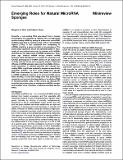Emerging Roles for Natural MicroRNA Sponges
Author(s)
Ebert, Margaret S.; Sharp, Phillip A.
DownloadEbert-2010-Emerging Roles for N.pdf (1.074Mb)
PUBLISHER_POLICY
Publisher Policy
Article is made available in accordance with the publisher's policy and may be subject to US copyright law. Please refer to the publisher's site for terms of use.
Terms of use
Metadata
Show full item recordAbstract
Recently, a non-coding RNA expressed from a human pseudogene was reported to regulate the corresponding protein-coding mRNA by acting as a decoy for microRNAs (miRNAs) that bind to common sites in the 3′ untranslated regions (UTRs). It was proposed that competing for miRNAs might be a general activity of pseudogenes. This study raises questions about the potential ability of thousands of non-coding transcripts to interact with miRNAs and influence the expression of miRNA target genes. Three years ago, artificial miRNA decoys termed ‘miRNA sponges’ were introduced as a means to create loss-of-function phenotypes for miRNA families in cell culture and in virally infected tissue and transgenic animals. Given the efficacy of miRNA sponges expressed from stable chromosomal insertions, it seemed plausible that natural non-coding RNAs might have evolved to sequence-specifically sequester miRNAs. The first such endogenous sponge RNA was discovered in plants and found to attenuate a miRNA-mediated response to an environmental stress. More recently, a viral non-coding RNA was observed to sequester and promote the degradation of a cellular miRNA in infected primate cells. In this review we discuss the potential and proven roles for endogenous miRNA sponges and consider some criteria for screening candidate sponge RNAs.
Date issued
2010-10Department
Massachusetts Institute of Technology. Department of Biology; Koch Institute for Integrative Cancer Research at MITJournal
Current Biology
Publisher
Elsevier B.V.
Citation
Ebert, Margaret S., and Phillip A. Sharp. “Emerging Roles for Natural MicroRNA Sponges.” Current Biology 20, no. 19 (October 2010): R858–R861. © 2010 Elsevier.
Version: Final published version
ISSN
09609822